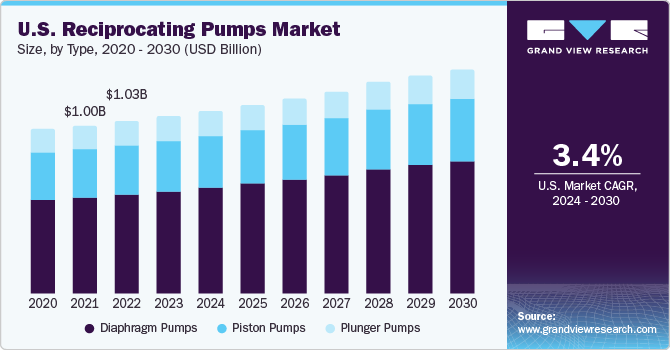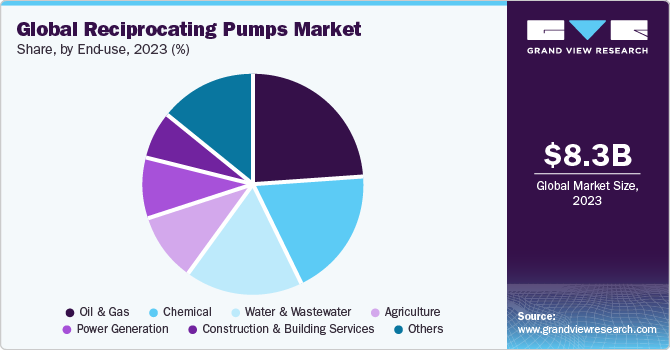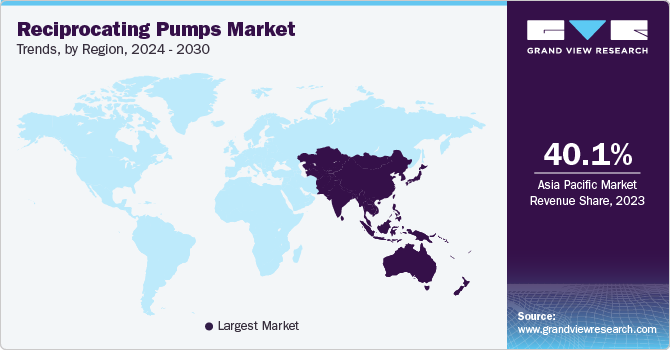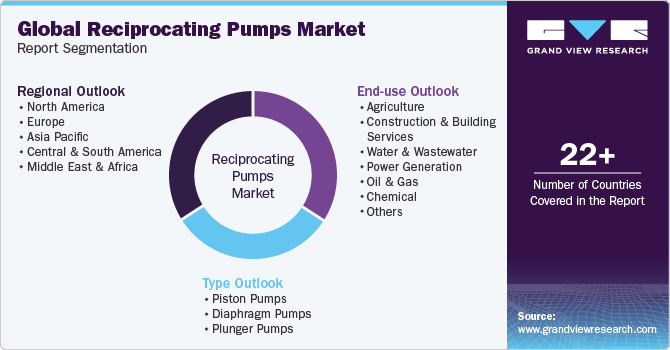- Home
- »
- Advanced Interior Materials
- »
-
Reciprocating Pumps Market Size And Share Report, 2030GVR Report cover
![Reciprocating Pumps Market Size, Share & Trends Report]()
Reciprocating Pumps Market (2024 - 2030) Size, Share & Trends Analysis Report By Type (Piston Pumps, Diaphragm Pumps), By End-use (Agriculture, Power Generation), By Region, And Segment Forecasts
- Report ID: GVR-4-68040-155-4
- Number of Report Pages: 130
- Format: PDF
- Historical Range: 2018 - 2022
- Forecast Period: 2024 - 2030
- Industry: Advanced Materials
- Report Summary
- Table of Contents
- Segmentation
- Methodology
- Download FREE Sample
-
Download Sample Report
Reciprocating Pumps Market Size & Trends
The global reciprocating pumps market size was estimated at USD 8.3 billion in 2023 and is anticipated to grow at a compound annual growth rate (CAGR) of 5.1% from 2024 to 2030. To generate high-pressurized fluid transmission in hydraulic systems, manufacturing systems, and injection & dosing systems, these pumps are essential. Hence, the market for reciprocating pumps is being driven by the expansion of numerous industries like manufacturing, chemicals, and wastewater treatment. Reciprocating pumps are positive displacement pumps that displace a fixed amount of fluid under pressure. They transfer the fluid from one place to another by increasing its pressure. They can be designed to achieve varying constant discharge rates. They are used to transfer gases and liquids across commercial, industrial, and residential applications.

The growth in the oil & gas industry in the U.S. is a key factor contributing to the rise in demand for reciprocating pumps. As reciprocating pumps are significantly used in the oil & gas industry for hydrocarbon exploration, production, and refining, the growth in the oil & gas sector in the U.S. is driving the market growth. Furthermore, the development of shale gas exploration by using the hydraulic fracturing technique in the U.S. is likely to propel the market growth.
The evolving needs of end-use industries and the rising importance of energy efficiency & sustainability showcase the future trends of the market. To cater to these needs, key market players are developing more energy-efficient pumps with less carbon footprint presence. These newly designed pumps have variable frequency drivers (VFDs) to enable better pump speed and flow control. Furthermore, some industries, such as chemical processing, require specialized reciprocating pumps to handle highly corrosive, viscous & acidic fluids. Hence, manufacturers are offering customization options and expertise to cater to those demands. Furthermore, most of the key market layers have adopted the modular designing approach, while designing the reciprocating pumps. In addition to that, companies are giving significant emphasis to offering IoT-based pump solutions.
The reciprocating pump industry is highly competitive and concentrated, with numerous players having expertise in product design and development. Companies in the global market are actively focusing on investing in research and development activities for diaphragm pumps which enables them to retain their market share, thereby further boosting the market growth.
Type Insights
The diaphragm pump segment held the largest revenue share of 57.6% in 2023. A diaphragm pump uses a diaphragm made up of flexible materials such as rubber or plastics instead of the piston to transfer fluids. Depending on the end-use pressure and flow rate requirements, the diaphragm pumps are actuated either by mechanical means or by compressed air. Key advantages of diaphragm pumps include their ability to handle a wide range of fluids, including viscous and abrasive fluid. They are also known for their leak-tight operation, making them suitable for applications where fluid containment is critical. In addition, diaphragm pumps are self-priming, which means they can start pumping without the need for external priming. Their versatility, reliability, and ability to handle challenging fluids make them a valuable choice to handle a wide range of fluids in food processing, pharmaceutical, oil & gas, and chemical processing industries.
The piston pump segment is anticipated to register the second-fastest CAGR of 4.8% from 2024 to 2030. It is a type of positive displacement pump used to transfer fluids by reciprocating the motion of a piston inside a cylinder. These pumps are used to generate high-pressure fluid flow. Due to these characteristics, they are commonly used in industries and applications that require precision, reliable outputs such as hydraulic systems and manufacturing machines. Piston pumps are known for their ability to generate extremely high pressures. They are often used in applications that require very high pressure, such as high-pressure water jetting, oil and gas well stimulation, and pressure testing. Moreover, piston pumps can handle viscous and abrasive fluids more effectively as compared to other reciprocating pumps. The piston design is less susceptible to wear and damage when pumping fluids with solid particles or high viscosity. Hence, they are preferred in oil & gas extraction, and wastewater treatment industries.
End-use Insights
The oil & gas segment held the largest revenue share of 24.2% in 2023. Reciprocating pumps are used in the upstream exploration and production (ExoPE) sector of the oil and gas industry. They are used in the hydraulic fracturing process. During this process, they are used to inject fluids at extreme depths to improve hydrocarbon recovery. In oil refining stages, high-pressure generating pumps are used to transfer crude oil from the wellhead to storage tanks or from one location to another within a production facility.

Reciprocating pumps are also used in the natural gas compression process. They help compress natural gas for transportation through pipelines for injection into reservoirs for enhanced oil recovery (EOR). Reciprocating pumps play a role in transferring liquefied petroleum gas (LPG) and natural gas liquids (NGLs) from production facilities to storage tanks or transportation vessels.
The chemical segment is anticipated to register the fastest CAGR of 6.2% over the forecast period. Reciprocating pumps find extensive use in the chemicals industry due to their ability to handle a wide range of chemicals with different pH levels. In the chemical industry, acidic fluids cause corrosion to the internal pump parts. To overcome this problem, diaphragm pumps are used to reduce the corrosive effect of acidic fluids on the inner components of pump. Furthermore, these pumps maintain precise control over fluid discharge rates and operate reliably under various conditions.
The quality of chemical processing often involves metering of chemicals for accurate dosing, so that product quality can be increased by controlling the process variables such as discharge rates and pressure of fluid. In the case of reciprocating pumps, it is easy to control these process variables. Hence, the reciprocating pumps are used to inject the catalyst with accurate quantity and create quality compounds in the chemical processing industry.
Regional Insights
Asia Pacific region held the largest revenue share of 40.1% in 2023. Rapid industrialization coupled with the growing demand for fluid handling in several countries, including China and India, is expected to boost the market potential. The agriculture, chemical, and food processing industry in the Asia Pacific is witnessing significant growth on account of rising, urbanization, and per capita income. Reciprocating pumps are prominently used in the agriculture sector in herbicide and pesticide spraying equipment.

Moreover, the economies in the Asia Pacific region are likely to flourish over the forecast period because of the rising investments by governments in the agriculture, power generation, and construction sectors. This continuous expansion of end-use industries like the hydraulic & pneumatic machinery industry and the hydrocarbon exploration industry is likely to generate more demand for fluid handling equipment, thereby driving the market growth for reciprocating pumps.
The Europe region held the second-largest revenue share in 2023. The growth in the market in Europe is expected to be significantly driven due to its developed industrial sector. Reciprocating pumps are used in various industrial processes to increase the pressure of fluids, especially liquids. They are used in processes such as paint & coating, hydraulic systems, and ultrahigh pressurized water cutting. With the increasing demand for these processes, the demand for pumps is expected to rise in this region. Furthermore, to reduce the carbon footprint in industrial processes and improve carbon credit, the demand for more efficient reciprocating pumps has been driving the market in the region.
The Middle East and Africa region is expected to grow at a significant CAGR of 5.6% over the forecast period due to high growth industries such as oil & gas and power generation industry. The Middle East & Africa is a major hub to produce oil & gas. Reciprocating pumps are used during the crude oil transferring and refining process. Moreover, Middle Eastern countries have been investing heavily in constructing facilities that can generate potable water from saline water. Reciprocating pumps are used for seawater intake, reverse osmosis, and brine disposal.
Key Companies & Market Share Insights
The manufacturers adopt several strategies, including acquisitions, mergers, joint ventures, and geographical expansions, to enhance market penetration and cater to the changing requirements of various end-use industries. Some of the major companies have undertaken measures such as technological upgrades and investment in research and development activities to penetrate the market. In August 2022, Atlas Copco AB completed the acquisition of LEWA GmbH and its subsidiaries. LEWA GmbH was a leading manufacturer of diaphragm pumps for metering systems. This acquisition might have helped Atlas Copco AB to improve its product portfolio.
Key Reciprocating Pumps Companies:
- Grundfos
- The Weir Group PLC
- LEWA GmbH
- Ruhrpumpen Group
- Fluimac pump solution
- Parker
- Gardner
- Denver Inc.
- Alfa Laval
- SPX Flow
- Flowserve Corporation
- IDEX Corporation
- Eaton
- Xylem Inc.
- Atlas Copco AB
- Ningbo Hilead Hydraulic Co., Ltd.
Reciprocating Pumps Market Report Scope
Report Attribute
Details
Market size value in 2024
USD 8.6 billion
Revenue forecast in 2030
USD 11.7 billion
Growth rate
CAGR of 5.1% from 2024 to 2030
Base year for estimation
2023
Historical data
2018 - 2022
Forecast period
2024 - 2030
Quantitative units
Revenue in USD billion, and CAGR from 2024 to 2030
Report coverage
Revenue forecast, company market position analysis, competitive landscape, growth factors, and trends
Segments covered
Type, end-use, region
Regional scope
North America; Europe; Asia Pacific; Central & South America; Middle East & Africa
Country scope
U.S.; Canada; Mexico; Germany; U.K.; Italy; France; China; India; Japan; Australia; Brazil; Argentina; Saudi Arabia; UAE
Key companies profiled
Grundfos; The Weir Group PLC; LEWA GmbH; Ruhrpumpen Group; Fluimac pump solution; Parker; Gardner; Denver Inc.; Alfa Laval; SPX Flow; Flowserve Corporation; IDEX Corporation; Eaton; Xylem Inc.; Atlas Copco AB; Ningbo Hilead Hydraulic Co., Ltd.
Customization scope
Free report customization (equivalent up to 8 analysts working days) with purchase. Addition or alteration to country, regional & segment scope
Pricing and purchase options
Avail customized purchase options to meet your exact research needs. Explore purchase options
Global Reciprocating Pumps Market Report Segmentation
This report forecasts revenue growth at country level and provides an analysis of the trends in each of the sub-segments from 2018 to 2030. For this study, Grand View Research has segmented the global reciprocating pumps market report based on type, end-use, and region:

-
Type Outlook (Revenue, USD Billion, 2018 - 2030)
-
Piston Pumps
-
Diaphragm Pumps
-
Plunger Pumps
-
-
End-use Outlook (Revenue, USD Billion, 2018 - 2030)
-
Agriculture
-
Construction & Building Services
-
Water & Wastewater
-
Power Generation
-
Oil & Gas
-
Chemical
-
Others
-
-
Regional Outlook (Revenue, USD Billion, 2018 - 2030)
-
North America
-
U.S.
-
Canada
-
Mexico
-
-
Europe
-
Germany
-
U.K.
-
France
-
Italy
-
-
Asia Pacific
-
China
-
India
-
Japan
-
Australia
-
-
Central & South America
-
Brazil
-
Argentina
-
-
Middle East & Africa
-
UAE
-
Saudi Arabia
-
-
Frequently Asked Questions About This Report
b. The global reciprocating pumps market size was estimated at USD 8.3 billion in 2023 and is expected to reach USD 8.6 billion in 2024.
b. The global reciprocating pumps market, in terms of revenue, is expected to grow at a compound annual growth rate of 5.1% from 2024 to 2030 and reach USD 11.7 billion by 2030.
b. Asia Pacific dominated the reciprocating pumps market in 2023 with a share of 40.1%, owing to the increasing investments in agriculture, water treatment to cater to the growing urbanization.
b. Some of the key players operating in the reciprocating pumps market include, Grundfos, The Weir Group PLC, LEWA GmbH, Ruhrpumpen Group, fuimac pump solution, Parker, Gardner, Denver Inc., Alfa Laval, SPX Flow, Flowverse Corporation, IDEX Corporation, Eaton, Xylem Inc., Atlas Copco AB, Ningbo Hilead Hydraulic Co., Ltd.
b. The increasing fluid handling requirements in various industries such as oil & gas, chemicals has been propelling the market. Further regulatory compliance and technological advancements in pump technology for energy efficient pumps are driving the market.
Share this report with your colleague or friend.
Need a Tailored Report?
Customize this report to your needs — add regions, segments, or data points, with 20% free customization.

ISO 9001:2015 & 27001:2022 Certified
We are GDPR and CCPA compliant! Your transaction & personal information is safe and secure. For more details, please read our privacy policy.
Trusted market insights - try a free sample
See how our reports are structured and why industry leaders rely on Grand View Research. Get a free sample or ask us to tailor this report to your needs.










